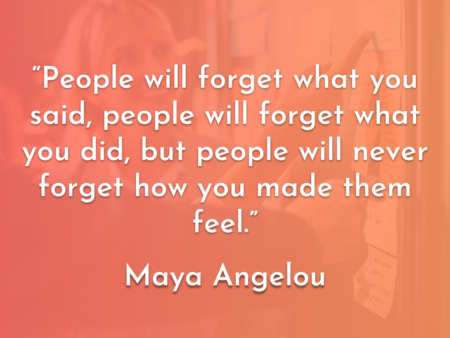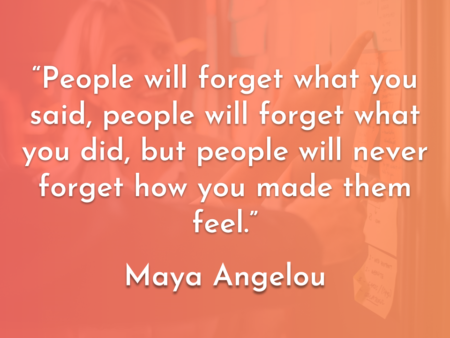
This is a guest post by Patt Hardie, Leadership and Talent Management Expert. It is the companion to the July 17, 2018 Voice America interview with David White, CIO of Battelle Memorial Institute in Columbus, Ohio, aired on VoiceAmerica “Innovative Leaders Driving Thriving Organizations”: Should IT Executives Share their ‘Soft Side’?
Soft skills have many definitions, one key being emotional intelligence. Research has provided clear evidence that emotionally intelligent leaders are more successful. Many of these studies yield bottom-line results. Yet, many leaders miss the mark. Why? Maybe they believe that strong leadership equates to being tough, they lack confidence, or don’t want to appear vulnerable in their role. Or some may believe it seems too ‘touchy-feely’ or soft. The ‘Soft Side’ of leadership spans beyond technical leaders to all leaders, and really isn’t about being soft (or any of those other things) at all. What it IS about is being confident and secure enough to be yourself with others; its about being humble, approachable and personable; and treating people with dignity, concern and appreciation. It’s also knowing your people, about having compassion and restraint; listening with purpose and responding with care; and caring about the impact of decisions on people. Finally, it’s about sincerity, self-awareness and learning. The ‘Soft Side’ of leading doesn’t eliminate the important responsibilities of managing performance and holding people accountable. It is a ‘both/and’ combination of strengths that leaders need to have to be successful.
As an IT Leader and someone who works in technology, David talks about why the soft side of leading is a significant contributor to success. As technology leaders, we need a diverse set of skills including a heavy dose of soft skills to be a highly successful business leaders beyond our technical skills. These skills range from awareness and management of our mood, an ability to be present and focused to skills in establishing and managing a positive culture where a broad range of perspectives can be explored and synthesized.
David has a strong understanding about the ‘Soft Side’ of leading and demonstrates it effectively.
The soft side of leading is a hot topic today for many articles and books under titles such as Authentic or Gracious Leadership, or the Genuine or Compassionate Leader because it couldn’t be more important than in today’s environment, in our culture, our communities, and in our organizations and its impact to bottom-line business results. The beauty of it all is that when leaders are willing to be their authentic self in business relationships with key stakeholders: teams, peers, customers, etc., great outcomes emerge: trust builds, morale and engagement increases, teamwork and collaboration multiplies within and between groups, and empowerment and accountability grows. Better decisions are made, ‘conflict’ becomes ‘problem solving’, and over time, if practiced by enough leaders, authenticity becomes part of the culture. The old saying that the leader sets the tone couldn’t be truer. All of these lead to higher performance and business results.
Maya Angelou, the American civil rights activist and poet once said, ‘I’ve learned that people will forget what you said, people will forget what you did, but people will never forget how you made them feel.’ Janet Smith Meeks, business leader says in her book Gracious Leadership: Lead Like You’ve Never Led Before ‘Gracious leadership represents the intersection of ultimate respect ad optimal outcomes.’ These inspirational quotes represent what the soft side of leading are ultimately about: Sharing the best version of yourself in service of others. Yet, how do you do that well? It’s often the little things surprisingly, it’s consistency over time. Here are a few tips with examples:
- Be personable, humble, authentic:
- Make eye contact, initiating conversation with those you encounter on the elevator, in hallways, in the cafeteria, in meetings (even if you’re introverted)
- Get to know your people, team members, key stakeholders; remember names, important information; let them get to know you
- Acknowledge mistakes, ask forgiveness; show gratitude; be sincere
- Ask for coaching, mentoring, training, support when needed
- Drop by offices or invite staff to your office to chat
- Have your meetings in the cafeteria or other casual spaces at the office
- Have lunch with team or 1-1 with team members/others
Author personal example: When I have meetings in cities where team members are located, I always make time to meet and have lunch with them to discuss current issues and learn more about them personally.
- Treat people with dignity, concern and appreciation:
- Show compassion with a personal note of condolence, get well card; work from home in special circumstance if you can, etc.
- Say thank you, send notes of appreciation
- Celebrate accomplishments/milestones individually/team
- Never be too busy to reach out to become aware of what’s going on with other’s needs
- Manage performance issues with dignity
- Do more listening than speaking so that others feel heard
- Give people undivided attention when they come into your office to talk; put everything down, don’t answer your phone
Author personal example: I recall a time when my team was working on a lengthy project and we were closing in on our deadline. We were working long hours, so over the weekend, I put handwritten motivational notes on small post-it’s on everyone’s desktop monitors… simple sayings like ‘Stay awesome… we’re almost there!!!’ and ‘Hang in there, you’re doing GREAT!!!’ I was amazed at the impact that small gesture had the following week on the entire team!
- Self-awareness and learning:
- Seek feedback for yourself from others regularly
- Know what you know, know where your gaps are; fill your gaps with learning and supplement some with smart people and utilize them well
- Be clear about your personal leadership philosophy; your own development plan; your organization’s mission/vision/values and share it all with your team and have them hold you accountable
Author personal example: In all my regular 1-1 meetings with team members, I always ask what else they need from me to help them in their role…
Leadership is about building the next generation of leaders. People want to know how their work contributes to the achievement of results and are eager to provide their discretionary effort. People want to feel fully appreciated for the work they do, they want to matter. Step up to the leadership they deserve and deliver them the best version of yourself that you can. You won’t disappoint, and neither will they… I promise!
As a reader of this blog and listener to the interviews, please consider enrolling in one of the innovative leadership online leader development program. For additional tools, we recommend taking leadership assessments, using the Innovative Leadership Fieldbook and Innovative Leaders Guide to Transforming Organizations, and adding coaching through our online innovative leadership program. We also offer several workshops to help you build these skills.
About the Author
Patt Hardie, Principal and Founder of The Hardie Group LLC, has 30 years of business experience across healthcare, chemical, utility, contract research and retail industries as an expert leadership consultant, coach, and advisor. Patt delivers impactful, practical solutions that support her clients’ leadership / team development and organizational challenges. She is recognized as a collaborative partner and progressive thought-leader who has the ability to connect with the business and synthesize needs into successful strategies for sustainable results.





